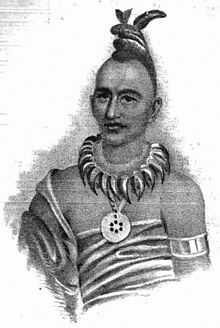Taimah
Taimah (1790-1830; var. Taiomah, Tama, Taima, Tiamah, Fai-inah, Ty-ee-ma, lit. "sudden crash of thunder" or "thunder") was an early 19th-century Meskwaki (Fox) leader. Often called Chief Tama in historical accounts.
Life

Taimah was the principal leader of a Meskwaki village near Burlington, Iowa, United States. Famous for saving the life of the Indian agent at Prairie du Chien by warning him of an assassination attempt. Signer of the 1824 treaty in Washington.[1] Taimah also maintained a village near Gladstone, Illinois in the 1820s.[2] He was interviewed in 1820 by Jedidiah Morse at Fort Armstrong:
The second chief of this [Meskwaki] nation is Ty-ee-ma... about forty years old. This man appears to be more intelligent than any other to be found either among the Foxes or Sauks; but he is extremely unwilling to communicate anything relative to the history manners and customs of his people. He has a variety of maps of different parts of the world and appears to be desirous of gaining geographical information.... He one day informed me when conversing upon this subject that the Great Spirit had put Indians on the earth to hunt, and gain a living in the wilderness; that he always found, that when any of their people departed from this mode of life, by attempting to learn to read write and live as white people do, the Great Spirit was displeased, and they soon died; he concluded, by observing, that when the Great Spirit made them, he gave them their medicine-bag, and they intended to keep it.— Jedidiah Morse (1822), A Report to the Secretary of War of the United States, on Indian Affairs: Comprising a Narrative of a Tour Performed in the Summer of 1820
Legacy

Namesake of Tama, Iowa, and Tama County, Iowa. The modern Meskwaki Settlement is near Tama. Son-in-law of Quashquame, he was mistakenly credited with being the leader of Quashquame's village by Caleb Atwater.[3] Taimah is buried near Des Moines County Highway 99 near Kingston, approximately "20 rods east" of a stone that bears his name, placing his gravesite approximately 1/4 mile from the Mississippi River in a small patch of land in the middle of a corn field, the land that his grave stands on has never been touched by any earth moving equipment, and is covered in trees, and foliage. The gravesite sits on private property, and is not open to visitors.
Taimah's son was Appanoose,[4] after whom Appanoose County, Iowa was named.